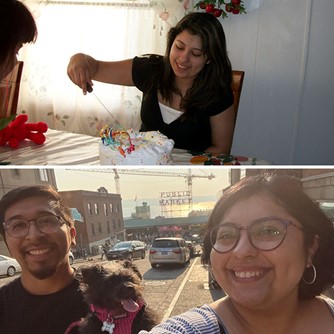PART THREE: From witnessing exceptional care and compassion given to children in their own lives, to receiving treatment first-hand, this weekly series features Seattle Children’s employees and the life experiences that drove them to pursue careers in healthcare.

Seattle Children’s has been part of Johanna Sánchez-Vargas’s life since she was 13 years old. Her family immigrated from Guerrero, Mexico to a small agricultural town in the Yakima Valley. There, the family planted roots and started working as farmworkers.
Throughout her childhood, Sánchez-Vargas experienced chronic pain and arthritis, and was treated in Seattle Children’s Rheumatology Program for spondyloarthropathies, a group of inflammatory diseases of the joints and areas where tendons attach to bones. It typically affects the lower part of a child’s body, including the hips, knees and ankles.
“Predominantly, I had persistent pain that hindered my ability to walk,” she said. “As a kid, I struggled with being visibly disabled. I remember going through the halls of my middle school with my wheelchair and feeling isolated for being different.”
Seattle Children’s has the only rheumatology program in the Pacific Northwest dedicated to children and teens, 17 and under. The team of experts, including doctors, physical and occupational therapists, nurses and social workers, provided care to Sánchez-Vargas at a critical time when she felt like her body was failing her.
“In a rural setting like the Yakima Valley, there is a lack of available expertise or resources to care for pediatric patients,” she explained. “Often, many families who are farmworkers must take their children to Seattle so they can receive the specialized healthcare they need.”
For five years, Sánchez-Vargas’ family made the lengthy commute to Seattle Children’s hospital campus for pediatric care.
“In the beginning, our trips were monthly,” she said. “Once we set up a routine with my care team, it became a quarterly endeavor. My family made so many sacrifices — emotional, financial and mental — to make sure I received the proper care. These visits take a financial toll on farmworker families who take unpaid days off to travel long distances to reach Seattle.”

Beyond the medical care, the trek was worth it to their family because Seattle Children’s was also the first place to offer Interpreter and Translation Services to Sánchez-Vargas’ parents.
“As a person whose first language is not English, there has always been a language barrier while accessing care,” she explained. “For years, I was the only person who spoke English in my family. I had no idea how I was going to translate ‘rheumatology,’ ‘spondyloarthropathy’ or any other medical terms to my parents. For the first time, I could just be a patient and the amazing translators would take care of my parents. It is terrifying to be in a new country where you don’t speak the language, and it’s even scarier when your child is sick and needs complex medical attention.”
Years later, Sánchez-Vargas’ returned to Seattle Children’s — not as a pediatric patient, but as part of its workforce.
“I’m in constant awe of the wonderful folks who work here,” she said. “Earlier this month, as a disabled, chronically ill and immunocompromised person, I had a reaction at the hospital campus vaccine clinic and the care team made me feel as safe as they did when I was a patient 10 years ago. One thing that has never changed about Seattle Children’s is the people. They are some of the most caring individuals who work to save lives, no matter the age.”
Now, as a Senior Communications Specialist, Sánchez-Vargas’ passion is to highlight impactful stories from patients, families and the workforce. She aims to use her lived experiences to bring forth stories from marginalized communities and push for more intersectional work from herself, her colleagues and Seattle Children’s.
Resources:
- Careers – Seattle Children’s (seattlechildrens.org)
- Rheumatology – Seattle Children’s (seattlechildrens.org)
- Physical Therapy – Seattle Children’s (seattlechildrens.org)
- Orthopedics and Sports Medicine – Seattle Children’s (seattlechildrens.org)
- Interpreter Services – Seattle Children’s (seattlechildrens.org)
- ‘Cancer Doesn’t Always Win’ | Sofia’s Personal Connection to “Hope. Care. Cure.” (seattlechildrens.org)
- I Know What it Feels Like’ | Meagan’s Journey – On the Pulse (seattlechildrens.org)

